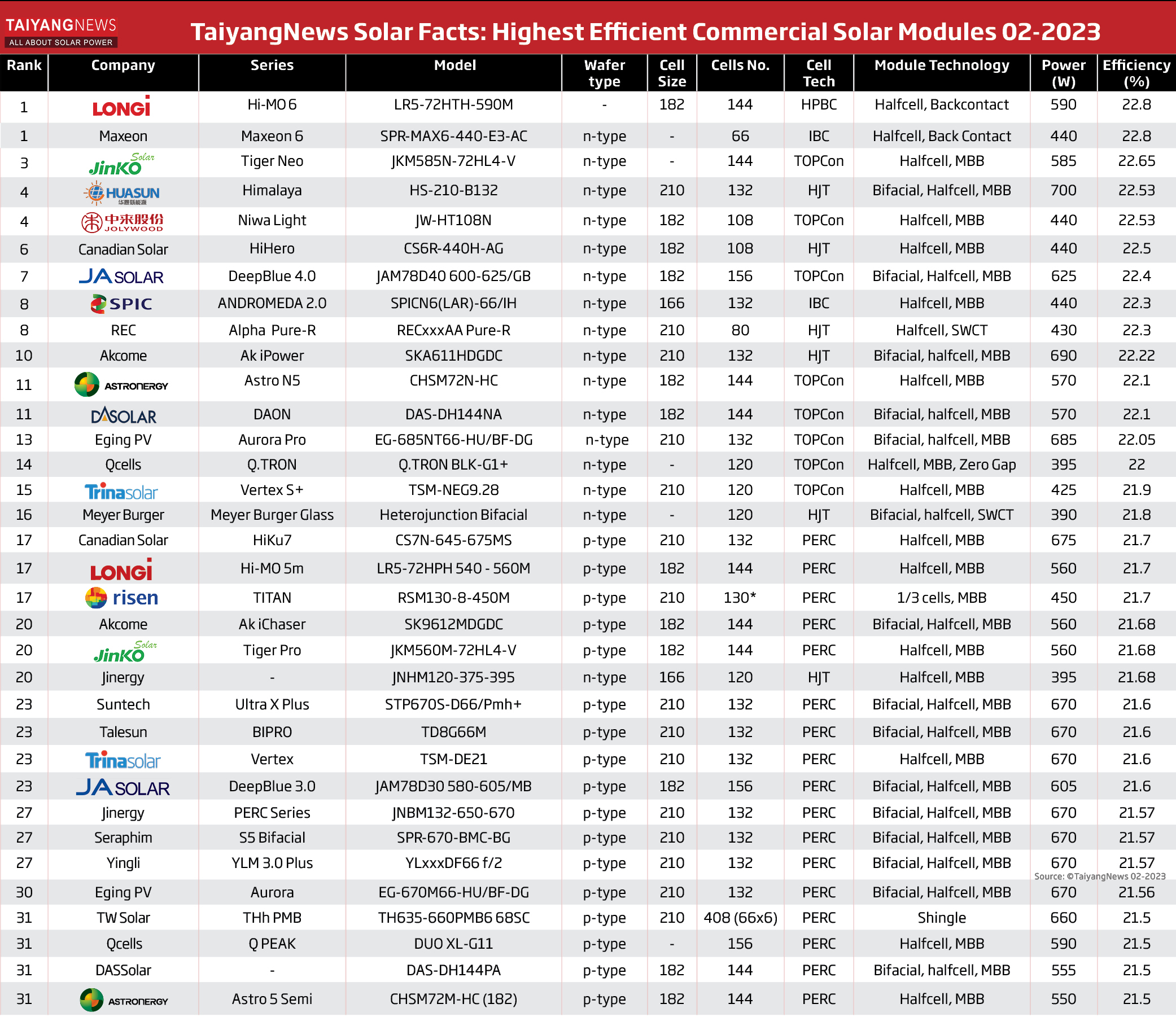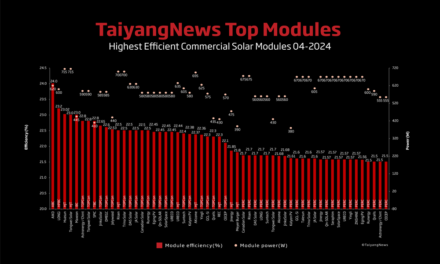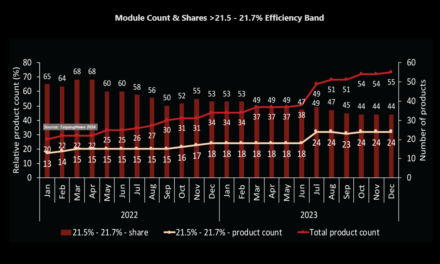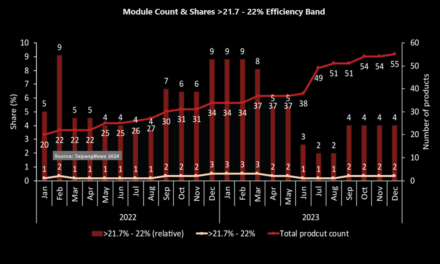- As China was on spring holidays, the number of products in February TOP Modules list remains at 34, while there were no changes in power/efficiency for any product
- Top ranking is still led by LONGi and Maxeon with 22.8% efficient solar modules
- The list includes modules using various cell technologies: 1x HPBC, 2x IBC, 8x TOPCon, 6x HJT and 16x PERC modules
With the major part of the PV value chain based in China, which mostly closes its manufacturing for the new lunar year’s spring break taking place this time in late January, it seems that companies have saved any new product announcements for the new year is. Our checks of the vertically integrated cell/module manufacturers’s published panel specs did not result in any new product or changes compared to the January edition.
For background: Efficiency and output power are the 2 key characteristics of a solar module. While there are several means to improve module power such as employing larger cell sizes or integrating more cells into a module, it’s the efficiency that truly speaks about the ability of the solar device to convert sunlight per area into power. That’s why this list includes only the highest efficient solar modules.
TaiyangNews has been covering the efficiency progress of solar modules through its annual reports on Advanced Module Technologies starting from 2017 and its annual conference as of 2020. Our latest Solar Module Innovations Report was published in Aug. 2022 (download report here) and the annual conference on Solar Module Innovations took place on Jan. 31, 2023 (access the presentations here). However, in the quickly changing solar sector a lot is happening over the course of a year – and to keep our readers updated about the efficiency progress more frequently, TaiyangNews has started this monthly column on commercial TOP SOLAR MODULES at the beginning of 2022.
Methodology
Before going into details, here is some background on the methodology and selection criteria: Since module efficiencies have been improving considerably in recent years, more than 0.5% average per year, to make the list rewarding for technically advanced products we put the minimum efficiency to be included at 21.5%. We have listed only commercially available top modules from each cell technology stream of one module maker. For example, if a company is offering 2 different product streams based on PERC technology that have more than 21.5% efficiency, then only the product with the higher efficiency is considered for this list. But if a module maker is offering, for example, products based on PERC and TOPCon that have efficiencies of 21.5% or above, then both the products are listed here. Efficiency is the only criteria for ranking in the list (whenever available in the specs, we have used two digits after the comma for efficiencies, otherwise one). However, as we see more often products with the same efficiency, in this case power determine the order. And when efficiency and even power are the same, we have listed the manufacturers in alphabetical order.
A commercially available module is considered a product for which the complete data sheet is listed on the module producer’s website. The efficiency and power data listed here is taken from the data sheet available on the respective company’s website. This also means we have not included any new product announcements without final technical data published as their modules specs often differ considerably from the products that are finally available for purchase, and some products presented at trade fairs are not even seeing the commercial light at all. Finally, we are only listing modules based on in-house produced cells of a respective module manufacturer, which means modules using externally sourced cells are not featured in this TOP MODULES list. If module specs listed on websites seem to have ‘conspicuously’ high efficiencies, we ask for certificates from third-party test institutes among other information before we include a product in the list.

Results & Changes
Meeting these criteria, according to our research (status first week of February 2023), a total of 34 products from 23 companies have made it to the current list. As mentioned above; there is no change compared to the previous edition.
The IBC modules from SunPower spin-off Maxeon have been the most efficient products in the market for many years. This has changed in November 2022 with the world’s largest wafer and module maker LONGi having introduced a new module series called Hi-MO6 with 22.8% efficiency that is at the same level as Maxeon’s products. LONGi’s latest panel is based on a proprietary HPBC cell technology, which is essentially a back contact cell architecture. While LONGi has not officially confirmed the wafer type, whether it is p-type or n-type, it is most likely to be p-type, whereas the other leading Chinese vertically integrated module manufacturers have opted to n-type for their next generation products after p-type PERC, no matter if TOPCon or HJT. Apart from being top class in efficiency, the new Hi-MO6 module series is powerful too. The module is built with 144 half cells based on M10 wafer format resulting in a rated power of 590 W, which is why it is listed above Maxeon’s product Maxeon 6 with 440 W labelled power. LONGi has also improved the power rating of its PERC Hi-MO 5m module series by 5 W to 560 W in January edition. however, nothing else has changed for the product. It is still M10 wafer based, integrated with 144 half cells and based on multi-busbar configuration.
As a result, Jinko Solar holds the 3rd position with its Tiger Neo TOPCon module JKMN-72HL4-V that is offered with a power rating of 585 W and an efficiency of 22.65%. Huasun and Jolywood share 4th position. Both products have the same efficiency of 22.53% but for different rated module power. Huasun’ HJT module with 700 W, the most powerful on the list, is based on G12 wafer size in a 132 half-cell configuration, while Jolywood’s product is based on TOPCon technology; it has M10 wafer size and 108 cell configuration. This Niwa Light product has a rated power of 440 W.
Canadian Solar holds the 6th position. The HJT module of Canadian Solar has an efficiency of 22.5%, employing G12 wafer format and is based on 108 half-cell configuration. Named HiHero, the module is rated at 440 W. Canadian Solar’s HiKu7 product in PERC category was a new entry to our previous version; this product came with 0.1% high efficiency than former BiHiKu7 series. HiKu7 is based on G12 wafer format and is built with 132 half cells and interconnected with MBB layout, and has rated power of 675W.
JA Solar’s DeepBlue 4.0 remains the same at 7th position. This is JA’s second module on the list but an n-type bifacial module that has an efficiency of 22.4% for a rated power of 625 W. It is built with 182 mm wafer format and 156 cell configuration.
SPIC’s IBC module, based on German solar research institute ISC Konstanz’s Zebra technology, stands 8th place; it has a rated power of 440 W and 22.3% efficiency. Again, it shares that rank with REC, whose Alpha Pure-R series HJT product has 22.3% efficiency and 430 W module power.
Akcome delisted in November, but reappeared in our January listing with two products. Until October, only the company’s HJT module was listed, but in January we also found their PERC module with 21.68% efficiency. An interesting change, however, is with its HJT module that has a lower efficiency of 22.22% compared to the previously listed product with 22.5%. While the product from the current list is built with 132 half cells based on 210 mm wafer size and reaches a rated power of 690 W, the previous product from the Hi-Chaser series used the same number of cells and form factor but had a total power of 700 W. Akcome’s HJT product stands at 10th place in our efficiency ranking. The PERC portfolio of the company is called Ak ichaser, which is bifacial, built with 144 half cells sliced from M10 cells and has a power rating of 560 W. It shares the 20th position with JinkoSolar’s Tiger Pro PERC module – both have identical efficiencies of 21.68%.
The Astro N5 TOPCon module of Chint Astronergy continues to reach an efficiency of 22.1%, which now means the 11th spot. Astronergy is employing 144 of M10 half cells to realize an output power of 570 W.
DAS Solar is a Chinese cell and module manufacturer from which we have listed 2 modules – one comes with TOPCon and another is based on PERC cell technology. The TOPCon module has an efficiency of 22.1% and 570 W power output. Based on bifacial technology, it is made of 144 cells of 182 mm. Eging PV’s AuroraPro series module is a TOPCon based bifacial module with an efficiency of 22.05%, which means the 13th place in our ranking. The module has a rated power of 685 W. Qcells, pausing in the TOPCon field of our ranking after September has reappeared in January. The latest TOPCon module of the company has a lower efficiency of 22%, a 0.3% dip in absolute numbers. This Q.TRON-BLKG1+ module is based on 120 half-cell configuration. The data specs do not reveal the cell size, but indicate that the module is built with 120 half cells that lead to a power output of 395 W. The 22% efficiency has earned the product a 14th rank in our list. In addition, a PERC module, from Qcells is also included in our list. The product line, called Q PEAK series, however, remained unchanged since out February 2022 listing with a rated efficiency of 21.5%.
The remaining 20 products listed are below 22%, of which one employs TOPCon cells, while 2 are based on HJT, and the bulk of 17 are PERC modules.
Trina Solar’s Vertex S+ is based on TOPCon technology and reaches the 15th position. This multi-busbar half-cell n-type module has an output power of 425 W and an efficiency of 21.9%. As previously, Meyer Burger is offering its HJT product with the same efficiency of 21.8% and power rating of 390 W. Jinergy is another HJT technology company, whose product is based on M6 cell format and reaches 21.68% module efficiency.
There are several module series with efficiencies slightly exceeding 21% available today as high efficiency cell architectures are not a must to reach that level, but in order to design products today beyond 21.6% the cell technology is key. As shown in the graphs, PERC has been in general not been able to support efficiencies above 21.6% today. Most of the modules with efficiencies above 21.6% are employing cells based on high-efficiency cell architectures such as IBC, TOPCon or HJT. Until recently LONGi and Risen were somewhat of an exception offering PERC modules with a high efficiency rating of 21.7%. Risen Energy’s 210 mm based 450 W PERC module shared the 17th rank along with LONGi’s 21.7% efficient 182 mm based 560 W model until our November edition, but Canadian Solar also joined the list last month with an efficiency of 21.7% based on 132 half-cell configuration with 210 mm wafer size and a rated power of 675 W. If rounded, the next 3 sharing rank 20 would also reach 21.7%, but the companies – Akcome, Jinko and Jinergy – have given 2 digits in their spec sheets. JinkoSolar’s Tiger Pro is a module with 21.68% efficiency based on 144 cell configuration resulting in a rated output of 560 W. Akcome has a bifacial product with the same number of cells, cell format and output of Jinko.
Of the further 13 listed products, all of which are based on PERC (except Jinergy’s HJT module), 5 reach 21.6%, 4 come with 21.5%, and 4 are rated in-between. The PERC products from Astronergy, Akcome, Canadian Solar, DAS Solar, Eging PV, JinkoSolar, Jinergy, LONGi, TrinaSolar, Qcells are also listed in addition to their high-efficiency products as these panels still meet our criteria of at least 21.5% efficiency.
Summary
As discussed above, our latest monthly high-efficiency module ranking (featuring the summary of our research in the first week of February) has not undergone any changes in product count, suppliers and also the detailed product specs. The synopsis remained the same: LONGi and Maxeon still share the No. 1 spot, JinkoSolar takes 3rd place, Huasun and Jolywood share 4th rank, followed by Canadian Solar, JA Solar, SPIC, REC, Akcome. While this is likely due to the recent spring holidays in China, expect a lot of module product news soon, now that the world’s solar products factory has fully returned to work to supply again more products for what is expected to be another record breaking year. Stay tuned for the next update next month.
PS: If you have spotted somewhere a solar module that meets our criteria and might be missing in this list, please send us the link of the website with the product specs to [email protected].
Disclaimer: While TaiyangNews is carefully conducting its research for the module data shown in this article and graphs, we assume no liability for its accuracy, completeness, or timeliness.














